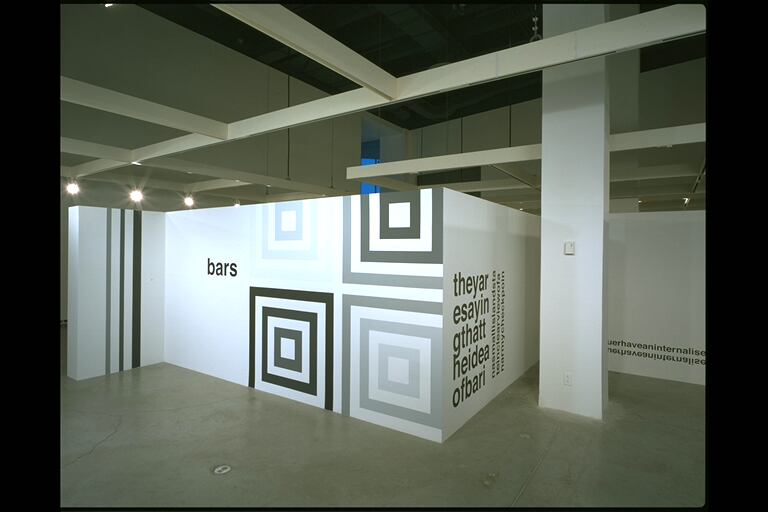Liam Gillick: communes, bars and greenrooms (2003)
This is the newsletter text to the Gillick exhibition communes, bars and greenrooms at the Power Plant, fall 2003. As I left The Power Plant before the exhibition opened (yet installed the exhibition), a publication was not produced.
photo: Cheryl O’Brien
Liam Gillick: communes, bars and greenrooms
The name of this exhibition, communes, bars and greenrooms, is also the subtitle of one of Liam Gillick’s recent books, Literally No Place. This coincidence points to a couple important issues to consider in approaching Gillick’s work at The Power Plant: firstly, Gillick’s practice is divided between a number of different pursuits and, secondly, each exhibition is only an installment in an ongoing investigation.
Sometime Gillick’s artworks are only the slightest of interventions or modifications of spaces. Sometimes they overwhelm the space, combining the look of corporate architectural design and office supergraphics with the colouristic formalism of minimal art. In the case of these larger installations, we might think that Gillick’s work has the look of another space out of place in an art gallery, that it seems more design than art. At this point, we might recall the title of his book: “literally no place” means the nowhere of utopia. The temporary architecture Gillick installs at The Power Plant then is an occasion to speculate on how “shifting concepts of ethics and conscience find form in the built world . . . when speculation becomes the dominant tool in defining our urban environment.” [1] As Gillick writes about the exhibition, the spaces of “the commune, bar and greenroom are specific locations for planning, speculation, reflection and constantly renewed forms of social interaction.” [2] While Gillick does not intend to make the individual spaces represent these environments, “the exhibition makes use of the social dynamic that is unique to each type of space, taking it as a base model for new forms of quasi-architecture and decoration.” [3]
Operating between a number of practices might make Gillick’s work somewhat unplaceable. Known particularly as an artist, Gillick has worked widely within the fields of design and architecture. Gillick does not want to create autonomous works of art that answer a restricted set of problems, preferring instead “a non-linear or non-progressive working technique that involves the development of parallel strategies.” Our role as spectators is somewhat analogous. Sometimes the work, rather than an object of pure contemplation, is backdrop or décor for discussions to take place. It is this sense that we understand Gillick when he says, “My idealism is rooted in discussion, negotiation, and the examination of compromised states.” [4]
Architecture and graphics frequently have been components of Gillick’s exhibitions; similarly, diagrams and texts have become integral to his work. At The Power Plant, the textual and the decorative are dominant within the architectural setting. Within the shell of the gallery proper, Gillick has constructed a second architecture. In plan, it looks like a cross between a maze and a decorative meander. With no external walls, centred in the gallery, it is open to the space around it, giving the appearance somewhat of booths at a trade fair. Each of the walls, as a sequence of inter-relating planes, however, have been particularized through all-over painted patterns or through the application of vinyl texts. Moving around this structure—its walls only two metres high—viewers will experience a variety of spaces opening up before them. Much like the sets of television or film, these spaces offer themselves temporarily for activation through performance.
The vinyl texts are developed from the position reached in Gillick’s book Literally No Place whose publication coincided with his 2002 exhibition The Wood Way. Here is what the artist said in an interview about their relationship:
The phrase “literally no place” is one way of understanding the word utopia. Once I had stolen the title I became more interested in something more concrete and functional than making general points about utopia, which is why the subtitle to the book is Communes, Bars and Greenrooms. To a certain extent, I’m interested in the idea of “functional utopia.” . . . What you end up with is not so much a mediation on utopia but an attempt to play with or expose certain kinds of functional utopias. It’s an echo of utopia, where glimpses are heightened. The bar, the commune and the greenroom are places where the pragmatising pressure to hold back ideas is suspended for as long as possible. You could argue that the exhibition is a demonstration of a compromised diagram of a functional utopia. You could suggest that the combination of factors involved, like the adjustments to the café and lecture theatre which leave the original elements all in place, acknowledge the potential of existing spaces and tries to heighten them without resorting to the corrupted language of renovation and short term control. While this will inevitably lead to collapses of understanding and realisation, it might also demonstrate the contradictions inherent in any contemporary attempts to resolve the paradoxes or our neo-liberal condition. [5]
Notes
1. Liam Gillick, “Semiotics of the Built World,” Liam Gillick: The Wood Way (London: Whitechapel Art Gallery, 2002), 81.
2. Email from Liam Gillick.
3. Ibid.
4. Gillick, “Semiotics of the Built World,” 82.
5. Liam Gillick and Anthony Spira, “Speculation and Planning,” Liam Gillick: The Wood Way, 21.




